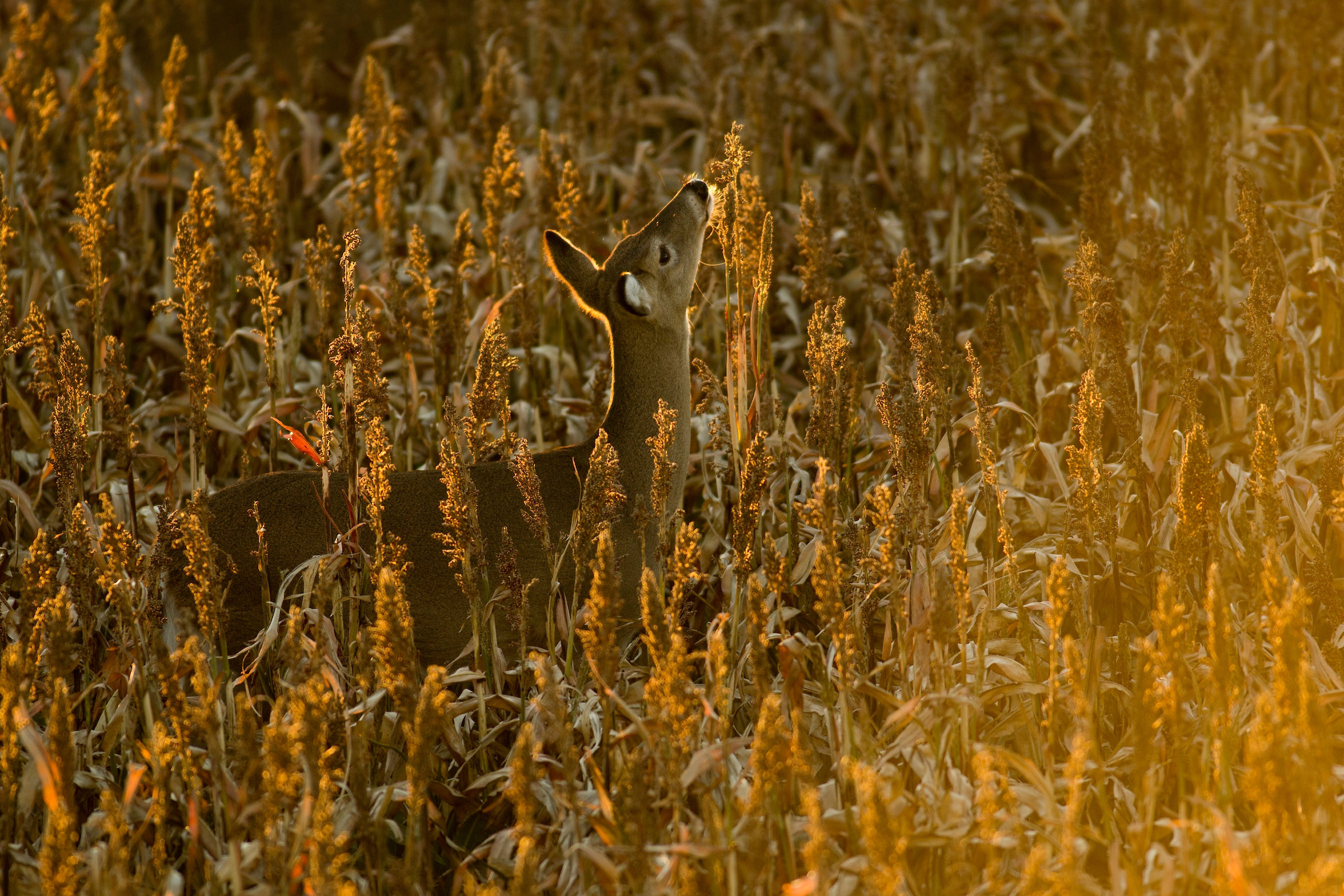Wyoming hunter Meg Stanton had to reread her mule deer’s chronic wasting disease results a couple times. The four-point buck she had shot in an old burn scar last fall had looked healthy. It showed no signs of disease. But the test came back positive for CWD and now Stanton had a decision to make.
She could throw out the animal she’d harvested, field dressed, and partially processed, or she could finish packaging the meat and eat it anyway. The Centers for Disease Control and World Health Organization advise hunters like Stanton not to eat a CWD-positive animal. Plenty of hunters do anyway.
She briefly weighed her options, then chose not to risk it. So just like thousands of hunters from Wyoming to Saskatchewan to Pennsylvania have also done, she hauled the quarters to the landfill. Then she had another decision to make: Would she keep deer hunting knowing this could happen again?
As CWD continues to spread across the country and prevalence rates in some areas creep upwards, wildlife managers have asked similar questions of hunters.
Will hunters quit buying deer tags because they’re concerned about getting CWD? And, will hunters hang it up after they’ve shot a few CWD-infected deer that wind up in a landfill?
How Hunters Think About CWD Risk
Bryan Richards, the emerging disease coordinator at the National Wildlife Health Center, says there’s an “ick” factor when it comes to CWD and venison.
“Human dimensions work suggests pretty clearly that at some point, when prevalence gets high, and I don’t know that there’s a pure definition of that, but when prevalence gets into 30 percent or 40 percent, either hunters or their families will alter their behavior,” he says. “At some point you go, ‘this is no longer worth it.’”
Surveys by Responsive Management, a research firm specializing in natural resource and outdoor recreation issues, have found that when the disease is discovered in a new location, license sales and participation drop, but they usually creep back up, says Mark Damien Duda, the company’s executive director.
Hunters have what he describes as a moderate level of concern, which is somewhere between head-in-the-sand pretending CWD doesn’t exist and being afraid to touch a piece of venison regardless of where it came from or if it was tested. People also tend to trust their state fish and game agencies, taking their lead.
On the flip side, Richards says plenty of people still knowingly eat animals that test positive.
Most survey respondents from a group of hunters in Wisconsin with CWD-positive deer said they planned to eat the venison, Richards says. A retired Wyoming wildlife disease specialist once told me that many hunters responded to positive CWD results by saying, “Thanks, I’m eating it anyway.” The caveat, he says, is those hunters were unwilling to feed CWD-infected meat to their children and grandchildren.
Richards often gives talks at sporting clubs and hunting groups about the possible danger of the disease and watches as people nod along.
“Then I’m done and walking outside and see three or four people are out there talking about CWD having a cigarette,” he says. “The messaging about tobacco use is pretty darned clear as well, but a lot of people have made a choice not to follow that health guidance. It’s all about risk tolerance.”
Read Next: Does Chronic Wasting Disease Infect Humans? Despite Shocking Headlines, Recent Research Suggests It Does Not
He’s found that even after decades of public information campaigns around CWD there still tends to be a general lack of awareness. One survey respondent said he wasn’t worried about CWD in venison because he always cooked his meat thoroughly. He appeared not to know, or understand, that prions can’t be destroyed through cooking.
While CWD messaging needs to continue, says Kip Adams, the chief conservation officer of the National Deer Association, many more hunters now understand CWD is a real disease wreaking havoc on deer populations. But health concerns aren’t making people stop hunting on a large scale.
“We hear stories about how Bob won’t hunt anymore because his wife won’t let him bring venison home,” Adams says. “But I don’t think that’s valid for a large number of hunters.”
A Problem for Meat Hunters
Photo by John Hafner
Fear of contracting the disease isn’t the only factor when hunters decide to continue — or stop — chasing deer. While many of us hunt for the tradition, camaraderie, and challenge that deer hunting brings, many others hunt mostly to fill their freezer with venison. In areas with high CWD prevalence, this becomes an issue of time, effort, and expense, when ultimately, the meat might end up in a landfill.
For example, a successful Western mule deer hunt can take all season, and states like Wyoming don’t provide a replacement tag for an animal that tests positive. Some herds in the state have prevalence rates as high as 65 percent, which means as many as six in 10 hunters each year could shoot a CWD positive buck.
In a state like Wyoming, which has plenty of public land, resident hunters could theoretically go somewhere else with lower prevalence rates.
Head east and the situation flips. Wisconsin replaces whitetail deer tags if hunters shoot a CWD-positive animal. But switching hunting areas in the Midwest and South becomes more challenging as plenty of whitetail hunters are locked into pricey hunting properties that they own or lease. Some families have hunted the same ground for generations.
“We hear anecdotes from hunters or landowners that after they’ve shot their fourth positive [deer] in a row in four years and thrown it away, that it’s hard to justify the money when they’re leasing the land,” Richards says. “If your family has been hunting in an area for 40 to 50 years and it’s a CWD zone, it’s really hard to pick up and move.”
Read Next: Here’s What Top Chronic Wasting Disease Researchers Can’t Say on the Record
Hunters Are Needed in the Fight Against CWD
In more than 30 years of studying CWD, hunting deer with CWD, and talking about CWD, Richards knows these two things: Hunting is one of the best ways to help fight the disease, and hunter numbers are decreasing.
State wildlife agencies don’t have comprehensive surveys on why hunter numbers have dropped. Likely reasons vary from lack of interest, access issues, and too many activities competing for attention. Could it also be that ick factor Richards referenced, or diminished appetite for throwing away meat?
He often circles back to how surveys show people say they’ll quit if they keep shooting positive deer, but “no states have proof other than license sales are dropping.”
For example, Wisconsin has lost about 60,000 deer hunters over the last 10 years, according to a report in the Washington County Daily News. Wisconsin has had CWD for decades and many counties have recorded prevalence rates above 20 percent. However state wildlife officials can’t tie the decline in hunting to the rise in CWD with so many other factors also in play (like Baby Boomers aging out of hunting).
Unfortunately, Richards says, quitting hunting because of CWD fears is likely the worst possible response for ultimately controlling the disease’s spread and prevalence rates. CWD spreads quickest when deer densities are highest. Cut down on the number of deer swapping snot, and that will reduce the number of deer with the disease.
It’s why Doug Duren, a Wisconsin landowner who’s been vocal in the fight against CWD, brings as many people as possible to hunt on his 600-acre family farm, which has a 30 percent prevalence rate. Last year, hunters killed a total of 47 deer on his place. He shot only one.
“I’m not that interested in hunting and killing stuff anymore,” he says. “But we have the opportunity to manage CWD, and if we don’t, Mother Nature is going to do it for us, and she’s pretty indiscriminate.”
As Duren sees it, the deer are going to die, either from a bullet or a horrible disease. He figures a bullet is better.
That’s also why Stanton, the Wyoming hunter, is also going to keep hunting deer. While she hated to throw away meat from an animal she harvested, she also knew she saved that buck from years of inevitable suffering and kept it from spreading the disease to other deer.
“I don’t know if [more deer] keep coming up positive if I would switch places or not,” she says. “But I do think we should do our part by harvesting deer and getting them tested to see if they’re CWD positive so we have more data. I’m afraid it’s more widespread than we know.”
Read the full article here




